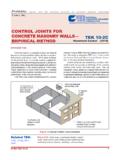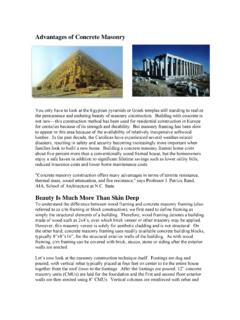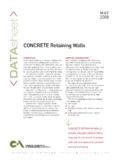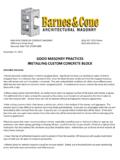Transcription of The Difference Between Cast Stone and Adhered Concrete ...
1 Submitted 9/16/08. For publication - Feb 2009 masonry Construction Magazine The Difference Between cast Stone and Adhered Manufactured Stone masonry Veneer by Bill Russell Chairman, cast Stone Institute Committee on Educational Standards On many construction documents today, there is confusion in both terminology and physical properties when a material is called out as cast Stone or Adhered Stone veneer. This article attempts to clarify the differences in the two products. DEFINITIONS. cast Stone is defined as a refined architectural Concrete building unit manufactured to simulate natural cut Stone , used in unit masonry applications.
2 cast Stone is a masonry product, used as an architectural feature, trim, ornament or facing for buildings or other structures. It is created to simulate all types of natural cut Stone and is referenced in the International Building Code under Chapter 14, Anchored masonry Veneer. The earliest known use dates to about the year 1138 and can still be seen at Carcassonne, France, a city that contains some of the finest remains of early architecture in Europe. cast Stone was first used extensively in London beginning around 1900 and has gained widespread acceptance in America since the 1920s.
3 According to Gary Fry, President of Board of Directors of the cast Stone Institute, Many lessons have been learned throughout this history and they can be used to improve the mason contractor's experience with cast Stone at the current state of the art. The requirements for cast Stone are referenced in the current ASTM International C1364 Standard for Architectural cast Stone which was originally approved in 1997 and most recently updated in 2007, although various trade groups had published specifications as early as 1927.
4 cast Stone is generally built into a load bearing masonry wall system, and used as an architectural feature, trim, ornament or veneer in traditional commercial and residential buildings and other structures. It is most often specified as a replacement for full bed-depth natural dressed dimensional limestone. Adhered Manufactured Stone masonry Veneer (AMSMV) is a lightweight man made Concrete masonry product which is usually cast into random sizes, in a variety of colors with a natural undressed quarried or cleft Stone finish.
5 It is sometimes referred to as Simulated Stone or Adhered veneer. AMSMV is generally applied as a residential or lightweight commercial masonry veneer Adhered to exterior and interior walls, structures, columns, landscape structures, and other structures suitable to receive lightweight Adhered units. It is known by a variety of different product names with a variety of proprietary specifications. Several Page 2 of 6 The Difference Between cast Stone and Adhered Manufactured Stone masonry Veneer companies manufacture Stone -like products that are used primarily as veneers on other substrate materials such as Concrete masonry units.
6 These simulated Stone products are manufactured to meet Construction Specifications Institute (CSI) Division 047300 classification for simulated Stone while cast Stone is manufactured to meet Division 047200 requirements. There are currently no ASTM standard specifications for AMSMV. PHYSICAL PROPERTIES. There are substantial differences Between cast Stone and Adhered veneer in regard to physical properties that should be considered when specifying. Adhered veneer is a lightweight product that is applied to a structural wall with an adhesive.
7 Therefore, it cannot be used to add to the load bearing capacity of the wall. cast Stone , however, can be used to add to the load bearing capacity of a masonry wall and is usually integrated into the brickwork, becoming part of a composite wall system rather than being Adhered to it. It provides additional strength because it is anchored within the masonry structure, therefore will stand the test of time. In addition, while Adhered Stone products are made light in weight so they will work easily on the exterior of other wall material, cast Stone weighs approximately the same as natural cut limestone.
8 Test methods dictate how the materials are tested while the specification stipulates what the requirements of the test results must be, as well as the ingredients each product must contain. PSI Absorption Unit Density Max Density cast Stone 6,500 6% 135pcf 40 psf AMSMV 1,800 - 2,000 22% (UBC Standard 15-5) 75pcf 15 psf For example, cast Stone is required to have a minimum compressive strength of 6,500 psi, maximum moisture absorption of 6 percent, and unit density of approximately 135 pcf. The minimum compressive strength of Adhered veneer is approximately 1,800 to 2,000 psi, absorption may reach 22% (UBC Standard 15-5), unit density is approximately 75 pcf, and much emphasis is put onto a shear bond test which is presently under development.
9 Each product must pass a rigorous freeze-thaw test. Because AMSMV is an Adhered unit, most building codes such as UBC/IBC require the maximum density to be 15 lbs per square foot, and allow the minimum thickness to be approximately . cast Stone when used in conventional 3-5/8 thickness weighs approximately 40 psf. APPEARANCE. The use of a high percentage of durable fine aggregate in any manmade Stone creates a very smooth, consistent texture for the building elements being cast , resembling natural limestone, brownstone, sandstone, marble or granite.
10 Applications that use cast Stone can range from the simplest window sill to the most complicated classical architecture. Therefore, the number of profiles and sizes required for any given project can vary from a single shape shown on a sketch to hundreds (or more) shapes, perhaps not so clearly shown in a set of architectural contract documents. AMSMV usually has a natural quarried Stone appearance and can be used for many of the same applications, although it is primarily used as Adhered veneer. Both products have many of the same properties inherent in a material which is primarily intended to simulate natural building Stone , although cast Stone is typically custom made to approved shop drawings and AMSMV is most often laid out and cut to suit field conditions.





